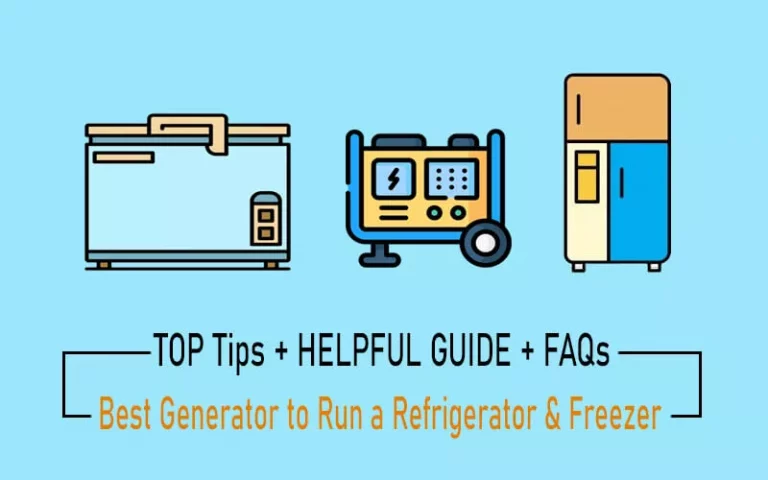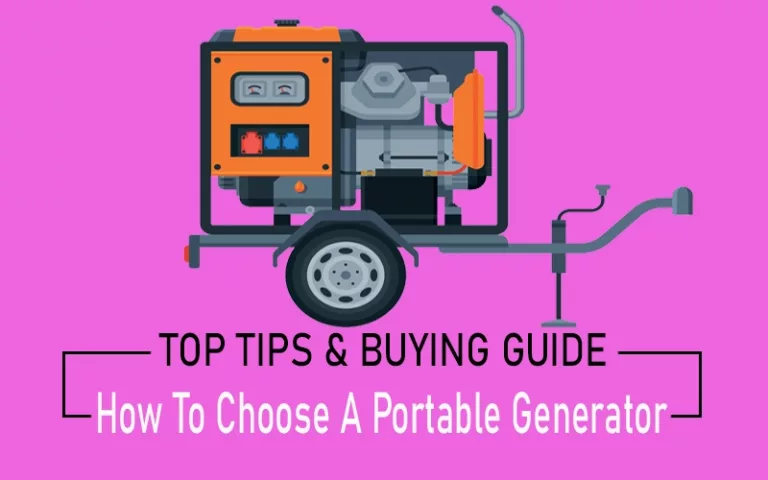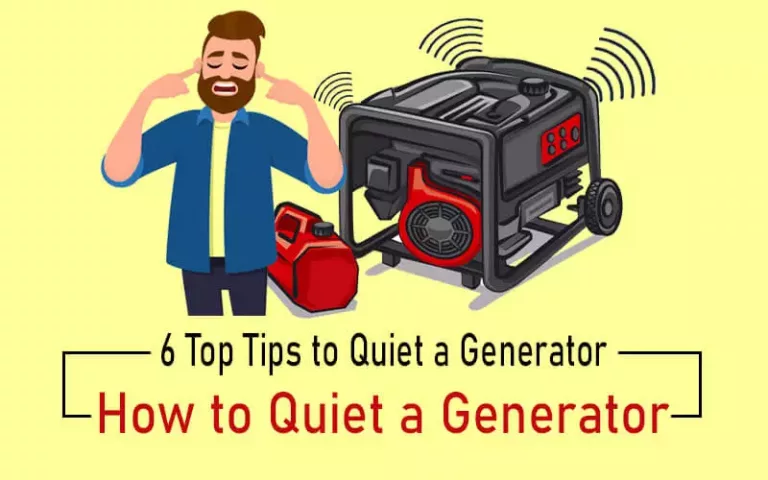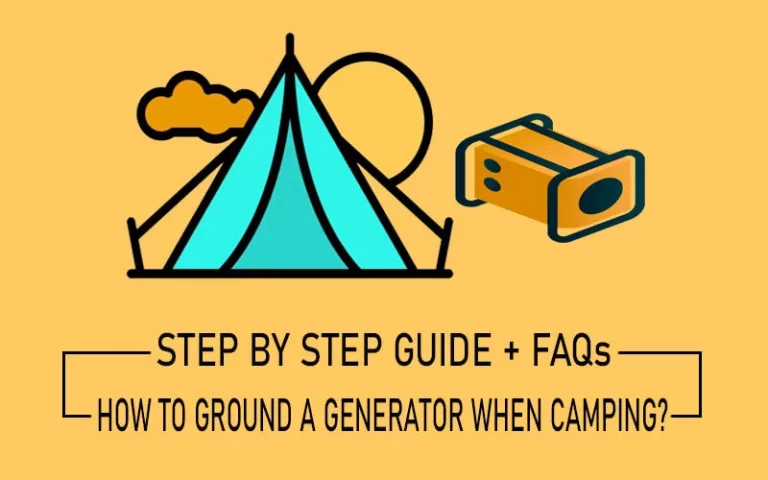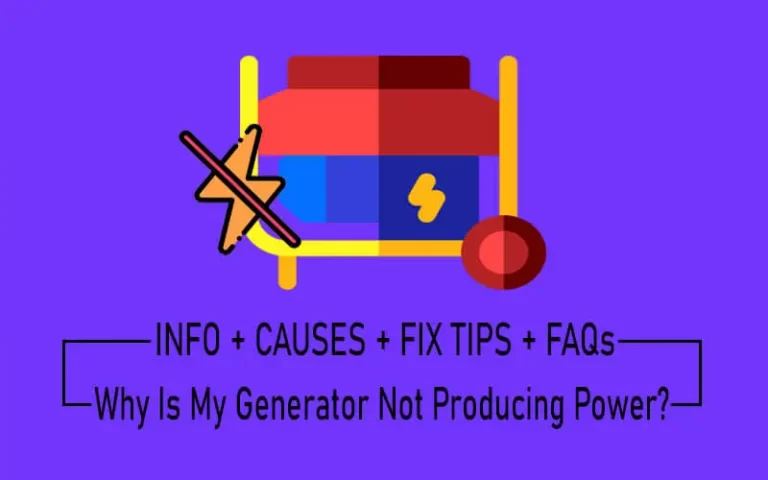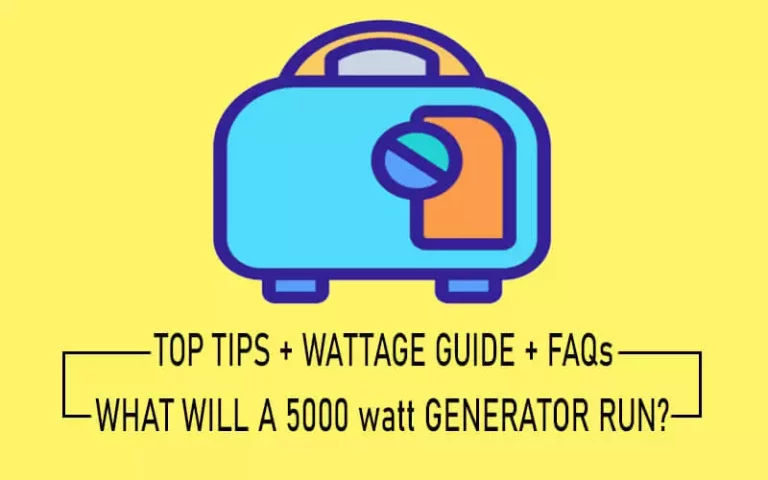What will a 10000-watt Generator Run [Watts Breakdown +FAQ]
A 10000-watts generator can be a powerful asset for your home or business.
It can provide backup power during an outage or be used to power tools and equipment on job sites. But what will a 10000-watt generator run?
Here is a breakdown of what you can expect from this powerful piece of equipment.
What Will a 10000-Watt Generator Run?
The wattage of a generator is an indication of how much power it can produce.
A 10,000-watt generator will be able to meet the needs of most businesses and homes, although you should check your appliances to see what they require before buying one.
A 10000-watts generator will likely power the following without a problem:
Businesses – businesses will have wall-to-wall electrical equipment that requires a constant power source.
These businesses may include restaurants, convenience stores, and grocery stores.
They may also need to operate a freezer or a refrigerator if they are open 24 hours a day. The generator should be able to keep the lights on and the doors open.
Homes – a 10,000-watt generator will provide enough power for most homes.
If you have a large home or will be using appliances that require continuous power (such as an electric cooktop) then you may need to look for a higher-wattage unit. For most homes, however, this generator is sufficient.
Recreation – many people enjoy camping and tailgating at events like football games.
A 10,000-watt generator will be able to power most recreational equipment including lights, televisions, tents, coolers, grills, and more.
If you plan on bringing larger appliances (such as a refrigerator or an electric heater) then you will need a higher-watt generator.
What will a 10000-watt Generator Run? Wattage Breakdown
| Appliances | Rated Watts |
|---|---|
| Refrigerator/Freezer | 700W |
| Microwave Oven – 625 Watts | 625-1000W |
| Coffee Maker | 800W |
| Electric Stove | 1500W |
| Dishwasher | 300W |
| Food Processor | 400W |
| Toaster Oven | 1200W |
| Toaster | 850W |
| Iron | 1200W |
| Washing Machine | 500W |
| Clothes Dryer – Electric | 3000W |
| Clothes Dryer – Gas | 700W |
| Light bulb – 60 Watts | 60W |
| Sump Pump | 1140W |
| Water well pump | 575W |
| Space Heater | 1800W |
| Humidifier | 175W |
| Furnace Fan Blower | 700W |
| Heat Pump | 4700W |
| VCR | 100W |
| Stereo | 450W |
| TV | 200W |
| Video Game System | 40W |
| Security System | 500W |
| Hair Dryer | 1250W |
| Curling Iron | 1500W |
| Electric Grill | 1650W |
| AM/FM Radio | 100W |
| CD/DVD Player | 100W |
| Mobile Phone Charger | 10W |
| Computer | 800W |
| Laptop | 300W |
| Laser Printer | 950W |
| Fax Machine | 65W |
| Copy Machine | 1600W |
| Quartz Halogen Work Light | 300-1000W |
| Airless Sprayer | 600W |
| Electric Drill | 440W |
| Belt Sander | 1200W |
| Air Conditioner | 1000-4000W |
| Air Compressor – 1/4HP | 975W |
| Air Compressor – 1 HP | 1600W |
| Hammer Drill | 1600W |
| Circular Saw | 2100W |
| Chain Saw | 1500W |
| Reciprocating Saw | 960W |
| Bench grinder | 1400W |
| Planer/Jointer | 1800W |
| Electric Leaf Blower | 1000W |
How Much Power do I Need to Run my Appliances?
First, add up how much wattage each device uses when operating.
If you have a refrigerator that requires 1500 watts but only 10 hours per day then it will use 150 kWh throughout the entire month (1500 watts x 10 hours = 15 kWh per day).
As you can see, appliances that use high wattage will add up quickly so it is best to only have the essentials on at one time.
A 10,000-watt generator can be used to power almost anything that runs off of electricity.
The following items typically use between 1000 and 5000 watts:
Refrigerators: Most large refrigerators require around 600 watts. Smaller dorm-sized refrigerators require around 300 watts.
Televisions: Your average 42-inch flat-screen TV requires around 600-700 watts. Larger TVs or those with higher definition will require more power.
And set the TV to “ON” mode rather than standby mode when you are using it on a generator so that it uses the full wattage.
Freezers: Your average dorm freezer requires around 700 watts. Larger freezers require around 1200-1500 watts.
Keep in mind that if you are hoping to power your freezer with a generator then it will likely need to be unplugged when not in use (unless you purchase an “automatic” generator).
If the power goes out and the generator is not yet running, it will shut off automatically when power is restored.
Appliances: Other small appliances such as microwaves and coffee makers usually require around 1200-1500 watts.
This generator should be able to handle several small appliances at once without a problem.
What are Starting Watts and Why are They Important??
The starting watts of a generator is the amount of power required to start it up.
A 10,000-watt generator will usually require around 8400 starting watts while running on economy mode (which consumes more fuel and has less power).
You can still use high-demand appliances such as a refrigerator and washing machine while the generator is on economy mode, you just run the risk of tripping a circuit breaker.
A generator will not use watts when it is on idle mode (if it has one) and will only start consuming wattage once you turn an appliance on.
What to Know When Running Your 10,000-watt Generator?
Generators offer both safety and convenience benefits.
However, you need to know what you’re doing when running a generator so that it operates correctly and provides power for your appliances safely.
It is important to read the owner’s manual thoroughly before using your generator (in case there are any particular precautions or additional equipment you will need).
Then follow these general guidelines when using your generator:
1) Only run one appliance at a time unless the generator’s manual says otherwise.
If you need to power multiple appliances (like an air conditioner and refrigerator), switch off the appliances every half hour or so (or use economy mode).
This is a safety precaution in case a circuit breaker trips.
If you are using multiple appliances that are in high demand, then you will likely need an electrical system upgrade.
2) Open your windows to avoid carbon monoxide poisoning.
Carbon monoxide is a poisonous gas created when fuel isn’t burned properly.
Make sure the generator is at least 20 feet away from your home’s doors and open windows or air vents.
The generator should be in a well-ventilated area that is free from dust and debris.
3) Never run your generator longer than necessary or until the fuel runs out (if it has an automatic shutoff).
If you need to use the generator for long periods of time, consider buying a larger wattage, upgrading your electrical system, or using an inverter generator.
4) If you plan on using a gas-powered generator, make sure to get the correct type of fuel (usually gasoline).
You should also know how to operate your generator properly and safely before use.
How to Safely Run Your 10,000 watt Generator? [Safety Tips]
Run your generator safely by following these tips:
1) Use a 10,000-watt generator when you need to power multiple appliances at once.
Appliances like air conditioners and refrigerators typically require a much higher wattage than a typical in-home electrical system can provide.
If you need to power appliances that demand a lot of energy, then a 10,000-watt generator is the best choice.
Your generator will be able to provide all the power your appliances need so it is safe for you to run multiple machines at once without blowing a fuse or circuit breaker.
2) Always set up and use your generator in a well-ventilated area with dust and debris removed.
Carbon monoxide, which is poisonous gas created when fuel isn’t burned properly, can be harmful to your health if you run a generator inside or near your home.
Make sure the generator is at least 20 feet away from doors and any open windows or vents.
3) Never let your generator run longer than necessary.
Permanently-fixed generators typically have no automatic shutoff so once the fuel runs out it will stop running.
Portable generators have an automatic shutoff that activates once the engine gets too hot.
Keep your generator cool by allowing it to rest for at least 30 minutes after every 3-4 hours of use.
This is very important if you are using fuel cans to supply your generator with power because there’s no way to tell how much fuel is available and when it’s going to run out.
4) Keep your generator dry and don’t expose it to any liquids or moisture.
Portable generators typically have a metal protective hood that protects the engine from water but this won’t help with rain or flooding.
Don’t leave your generator running outside during a storm because it will attract lightning and the electrical components can be damaged.
If you own a permanently-fixed generator, make sure your area is clear from debris and don’t let it get wet.
5) Always turn off your generator before refuelling.
This will prevent fuel from leaking onto hot engine components, which can cause a fire hazard.
Don’t smoke around the generator while refuelling either because flammable vapours can spread from the gas tank to the generator.
Flammable vapours are heavier than air so they’ll collect at ground level and create a potential explosion hazard.
If you follow these guidelines, your 10,000-watt generator will be safe to use when the power goes out during an emergency or natural disaster.
You should store your standby or portable generator in an open area with plenty of good airflows so it will be ready to power multiple appliances when the electricity goes out.
How long does a 10000-watt generator run per gallon of gas?
A 10000-watts generator running a 1050 square foot home will use about 9 gallons per hour.
How long will a 10000-watts generator run on propane?
The generator will run for about 8.5 hours on a 20 lb propane tank.
How long does a 10000-watts generator run on kerosene?
The generator will run about 18 hours on a gallon of kerosene.
How long does a 10000-watts generator run off batteries?
A generator with a 1000 watt load will run for about 7 hours when the battery bank capacity has been fully charged.
FAQs: What will a 10000-watt Generator Run?
Can I Power My Central A/C with a 10,000 Watt Generator?
If you’re in an area with frequent blackouts, then a 10,000-watt generator is the best choice for when the power goes out.
You should also check your circuit breakers to ensure they are heavy-duty enough for the load (or upgrade your electrical system).
The largest AC unit required by code is 55 amps (which is equal to 3600 watts) and that’s at full capacity (20 amps per leg or 1600 watts).
You will need an electrical system upgrade if you plan on running your central air conditioner with a 10,000-watt generator.
Will a 10000-watts Generator Run Central Air??
A 10000-watts generator can handle running your central air conditioning because it uses a lot of power (24 amps).
If you need to run multiple appliances at once, make sure everything is plugged into the appropriate number of watts.
For example, you’ll need 2-4 kilowatts for each window unit and 5-10 kilowatts to run a central air conditioner.
Many window units are 3 kilowatts each so you’ll need at least 6 of them to keep your whole house cool with just one generator.
Each central air conditioning unit is between 5-10 kilowatts so in this case, you’d need 2-4 generators running at the same time.
What happens if I start up my generator and there isn’t enough power?
When you first plug your appliances into a generator, you want to make sure that there is enough power for everything.
If not, the generator will only draw enough power (and start-up) for what it can handle.
The rest will be handled by your home’s electrical system (which means you may lose power).
If you are starting up multiple appliances on low wattage then a 10,000-watt generator is a great choice.
Remember that your refrigerator will require 600 watts per hour if it uses the standard 4-5 amps.
Can I use a larger generator than the one required to power my appliances?
Absolutely! A generator is capable of running as many appliances as it can handle so you should purchase as large of a generator as you can afford.
A larger generator will use less fuel and run more efficiently but won’t power appliances any faster than smaller ones.
10,000-watt generators can typically handle several large appliances at once without running out of power.
Just keep in mind that these generators are large and heavy so transporting them may be difficult depending on your vehicle and the situation.
Final Verdict
A 10000-watts generator is a powerful asset for your home or business. It can provide backup power during an outage, or be used to power tools and equipment on job sites.
I hope now you know what will a 10000-watt generator run?
You just need one that meets the demands of your needs- whether it’s powering up lights in emergencies, running your TV after a storm knocks out electricity for hours, charging cell phone batteries when you’re off-grid camping, or supplying enough juice to run saws and drills at worksites where there’s no access to commercial electric service.


